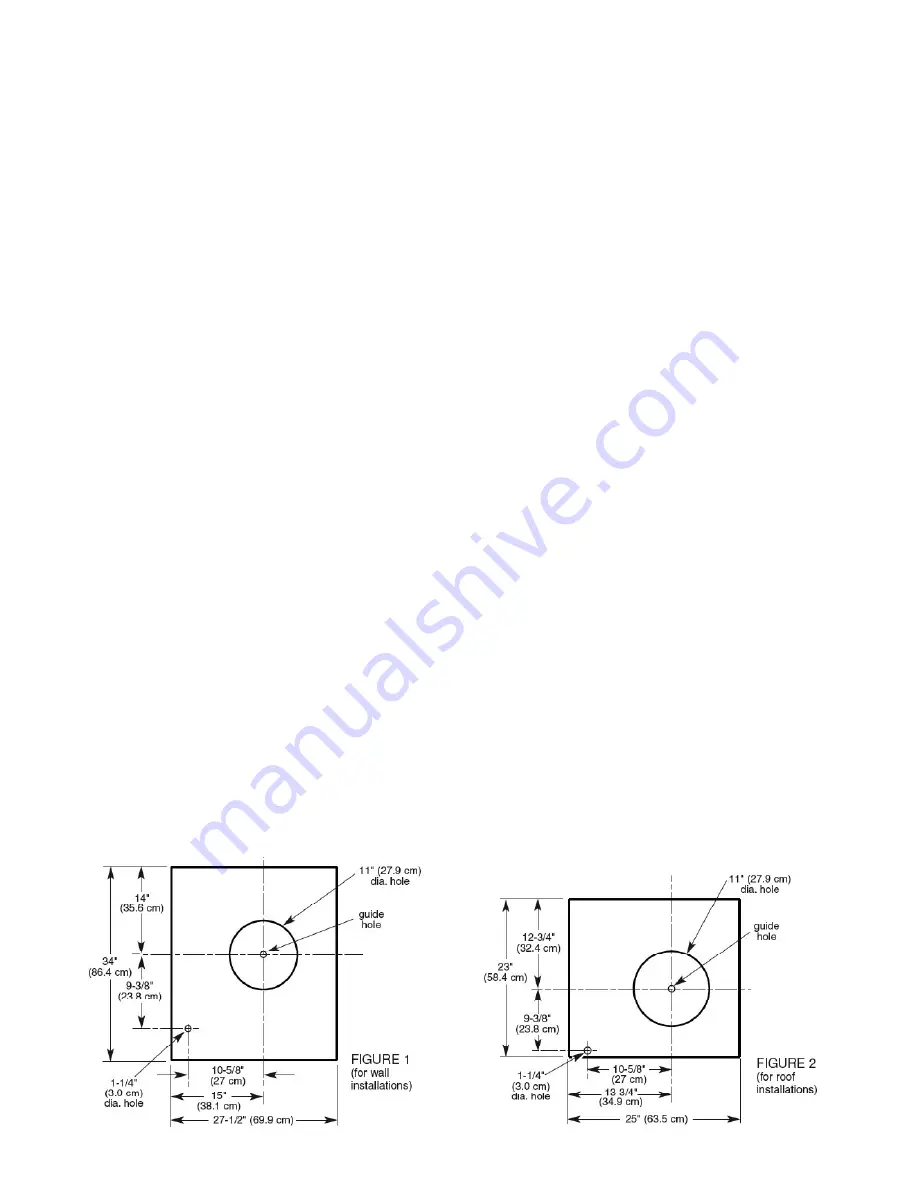
Version 05/06 - Page 3
1.
Choose a location on an outside wall where no wall studs, wires,
pipes, etc. run through the opening area. A minimum distance
of 24" (61 cm) from remote blower to ground may be required
depending on local code. Make sure to leave room for anticipated
snowfall in your region.
2.
Drill the guide hole in the center of the 11" (27.9 cm) diameter
opening area.
3.
Mark a 27-1/2" x 34" (69.9 x 86.4 cm) rectangle on wall as
indicated in
FIGURE 1
.
4.
Cut a rectangular hole in the siding only. Do not cut sheathing.
Nail down all siding ends.
5.
Mark an 11" (27.9 cm) diameter circle around guide hole as
indicated in
FIGURE 1
. Mark center of the 1-1/4" (or 3.0 cm)
diameter hole for electrical wiring as indicated in
FIGURE 1
.
6.
Cut 11" (27.9 cm) diameter hole in sheathing. Drill the 1-1/4"
(or 3.0 cm) diameter electrical wiring hole.
7.
Run a large bead of caulk on the back side of the housing along
the outer edge.
8.
Center the remote blower ring in the 11" (27.9 cm) diameter
hole, making sure that the 1-1/4" (or 3.0 cm) diameter electrical
wiring hole lines up with the hole in the wiring box.
9.
Attach the remote blower to wall using screws appropriate for
your installation. All four holes in the back panel must be filled to
prevent moisture that may get inside the remote blower housing
from leaking into the home.
10.
Seal all around the mounting screw heads with caulk.
11.
Go to
“Make the duct & electrical connections”
, Page 4.
Wall installations
Roof installations
FOR FLAT ROOF INSTALLATIONS SEE NEXT PAGE
1.
Choose location on rear slope of roof that minimizes vent run.
Avoid obstacles such as TV leads, electric lines, etc. If remote
blower top is level with roof peak, it will not be seen from street.
Remember this location as you work from inside the attic.
2.
Mark a point half-way between the rafters and drill a guide hole
at this point.
3.
From the outside, using the guide hole as a starting point, mark
the rectangular cut-out as indicated in
FIGURE 2
. Remove ONLY
the shingles in THIS AREA.
4.
Mark an 11" (27.9 cm) diameter circle around guide hole as
indicated in
FIGURE 2
. Mark center of the 1-1/4" (or 3.0 cm) diameter
hole for the electrical wiring as indicated in
FIGURE 2
.
5.
Cut out the roof boards along the 11" (27.9 cm) diameter circle.
Drill the 1-1/4" (or 3.0 cm) diameter electrical wiring hole.
6.
Remove roofing nails from the upper two-thirds of the shingles
to allow the back flashing sheet on the remote blower housing to
fit under them.
7.
Center the remote blower ring in the 11" (27.9 cm) diameter hole,
making sure that the 1-1/4" (or 3.0 cm) diameter electrical wiring
hole lines up with the hole in the wiring box.
8.
Attach the remote blower to roof or frame using screws appropriate
for your installation. All four holes in the back panel must be filled
to prevent moisture that may get inside the remote blower housing
from leaking into the home.
9.
Seal all the shingles around the remote blower housing, flashing
sheet, and mounting screw heads or frame with roofing cement.
Top and side flanges of the back plate may be covered with trim. It
is recommended that electrical connection be made and checked
first. Do not block the vent grill opening at the bottom of the trim.
Doing so will decrease blower performance.
Figure 1- Wall installations
Figure 2 - Roof installations


























